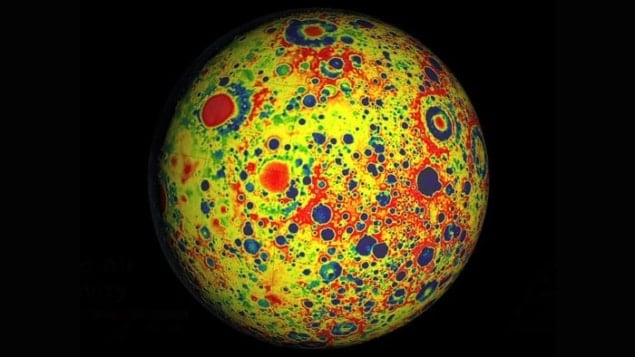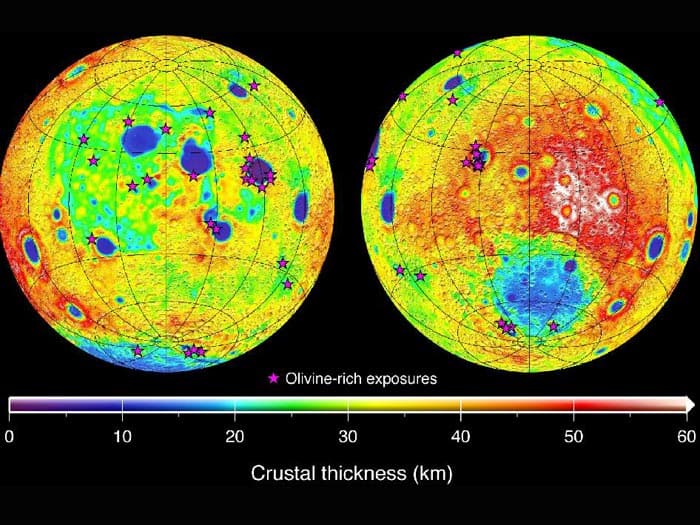
The first results from NASA’s Gravity Recovery and Interior Laboratory (GRAIL) mission have been released. The new high-resolution gravity data reveal surface structures that were not previously seen. The data have also shown that the lunar crust is less dense and more fractured by massive impacts than had previously been thought. The mission has also spotted subsurface dykes buried deep within the lunar surface – these suggest that the Moon experienced a period of expansion while it was still forming. Furthermore, the GRAIL data have been used to create the highest resolution gravity map of a celestial body other than Earth.
Launched in September 2011 from Cape Canaveral in the US, the main aim of the $495m mission is to accurately map the gravity of the Moon using twin spacecraft named Ebb and Flow. GRAIL entered lunar orbit in December 2011 and its prime-mission science phase stretched from 1 March to 29 May this year, during which its twin spacecraft were in tandem orbits around the Moon at an average altitude of 55 km.
Far side of the Moon
The Moon is an ancient, airless, waterless body that is untouched by erosion – this means that its surface and interior preserve a record of what was going on in the young solar system. However, it has been difficult to study the Moon’s gravity and interior in its entirety because only one hemisphere ever faces the Earth. To overcome this, the GRAIL mission involves the continuous monitoring of tiny changes in the distance between two spacecraft as they orbit the Moon. These changes are caused by perturbations in the Moon’s gravitational field, which are related to topographic features and changes in density below the lunar surface. From these measurements, the researchers stitched together a high-resolution gravity map that shows that the Moon’s internal gravitational field is consistent with an extremely fractured crust.
Three papers based on the new data have been published in the journal Science by the international team of GRAIL researchers. In the first paper, head of the GRAIL mission Maria Zuber, of the Massachusetts Institute of Technology, and colleagues focus on the overall gravity map of the Moon and point out previously unseen tectonic structures. These include volcanic landforms, basin rings and crater peaks. Surprisingly, the team also found evidence that beneath the surface the lunar crust is almost completely pulverized. This suggests that during the first billion years of its life, the Moon may have endured much more fracturing from massive impacts than previously thought. This would also apply to the Earth and other terrestrial planets, and could have an important effect on planetary evolution.
Tantalizing topography
To find the gravitational field for the Moon’s interior alone, Zuber’s team used topographic measurements from a laser altimeter aboard the Lunar Reconnaissance Orbiter (LRO), a separate spacecraft in orbit around the Moon. The scientists calculated the gravitational field that they expected the Moon’s topography to produce and then subtracted that field from the field measured by GRAIL. The team found that most of the local variations in the Moon’s gravity are caused by surface features, such as crater rims and mountains.
In the second paper, Mark Wieczorek, of the Institut de Physique du Globe de Paris, and colleagues show that the density of the Moon’s upper crust is less than previously thought and probably more porous. In most places on the Moon, they researchers found that the crust ranges in thickness from 34–43 km. However, the team also found that the crust beneath some major basins is now almost non-existent, indicating that early impacts may have excavated the lunar mantle.
Expanding theories
In the third paper, Jeffrey Andrews-Hanna, of the Colorado School of Mines, and colleagues report that the lunar crust appears to be riddled by igneous dykes. These are large sheets of cooled magma – hundreds of kilometres across – that seeped into the crustal fractures. The team believes that the dykes may have formed during a period of expansion early in the Moon’s history. According to Zuber, such fractures could affect the way a planetary body loses heat, while providing a pathway for the transport of fluids in its interior.
The researchers also point out that both GRAIL spacecraft have performed better than expected – the spacecraft are 200 km apart and they need to accurately measure the changes in the distance between them to within a few tenths of a micron per second. Instead, the spacecraft have outperformed and can resolve changes in distance to several hundredths of a micron per second.
Currently, GRAIL is on its extended mission for another three months, for which the team has a new set of objectives. The spacecraft have been lowered to half their original altitude; being closer to the Moon’s surface will greatly increase the resolution of collected data. The researchers are keen to see what new results the data will reveal.




